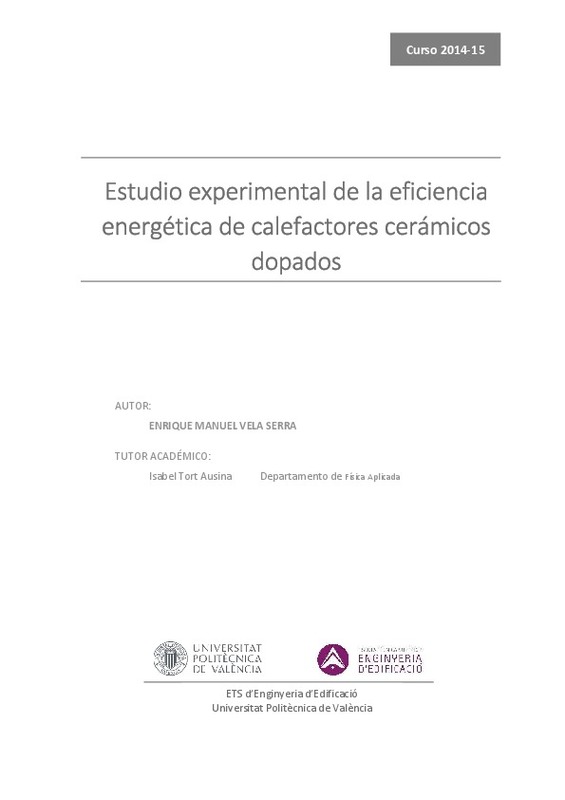|
[ES] Los arquitectos técnicos contribuyen a mejorar la eficiencia energética de los edificios haciendo que estos tengan una menor demanda de energia, que contaminen menos en su proceso constructivo o diseñando sus equipamientos ...[+]
[ES] Los arquitectos técnicos contribuyen a mejorar la eficiencia energética de los edificios haciendo que estos tengan una menor demanda de energia, que contaminen menos en su proceso constructivo o diseñando sus equipamientos con materiales más eficientes. Este TFG se centra en desarrollar un nuevo tipo de calefactor más eficiente y en estimar su ahorro. Para ello se ha combinado la cerámica con un compuesto susceptor de las microondas, consiguiendo asi un material capaz de calentarse rapidamente y que gracias a la elevada inercia térmica de la matriz cerámica tarda mucho más tiempo en disipar este calor. La primera parte del trabajo consiste en la busqueda de los materiales con que desarrollar este calefactor. Para ello, las composiciones que daban resultados positivos se introducían en un horno microondas al cual iba acoplado un pirómetro optico, midiendose el tiempo que tardaba en aumentar su temperatura y el que empleaban para enfriarse. Con estos datos se ha desarrollado el material definitivo con el que se ha construído el prototipo de calefactor. El siguiente paso es estimar el ahorro energético mediante ensayos y realizar una comparativa entre los resultados para conseguir asi una estimación del ahorro energético obtenido. La última parte del trabajo consiste en comprobar si este sistema de calefacción puede mejorar la eficiencia energética de una casa y estimar los kg de CO2 que pueden ahorrar en comparación con otros sistemas de calefacción. Para ello se diseña una vivienda tipo en el programa Ce3x con la que se obtendrán diferentes certificados energéticos en función del tipo de calefactor empleado. Tambien se realizarán cambios en el diseño de la casa para ver de qué manera pueden afectar éstos a las emisiones de CO2. Con todos estos datos se extraen las conclusiones del trabajo.
[-]
[EN] Technical architects can help to improve the energy efficiency of buildings making them less energy demanding, less polluting during construction process or designing them with more efficient equipment and materials. ...[+]
[EN] Technical architects can help to improve the energy efficiency of buildings making them less energy demanding, less polluting during construction process or designing them with more efficient equipment and materials. This bachelor's thesis focuses on developing a more efficient heater and estimating its savings. A new ceramic material combined with a microwave susceptor compound has been developed, thereby producing a material that is able to heat up quickly when subjected to the microwaves and it's very slow to dissipate the heat due to the high thermal inertia of the ceramic matrix. The first part of the work involves the searching for the rightful composition with which develop a new more efficient heater. Compositions that gave positive results were introduced into a microwave oven to which was attached an optical pyrometer, measuring the time that took to raise its temperature and to cool down. The final material used for the Microbiotech heater was developed using data obtained from these tests. Once a prototype of the heater was built, the next step was to estimate the energy savings that can be achieved and then proceed to check whether this heating system can improve the energy efficiency of a house estimating how many kilograms of carbon dioxide could save compared to other heating systems. For this, a prototype house was designed in the Ce3x program to obtain different energetic certificates depending on the different heating systems applied. These prototypes were studied to see how they vary in their emissions. Changes were also made in the house's design in order to calculate how this changes may affect CO2 emissions.
[-]
|





![MS Powerpoint file [PP]](/themes/UPV/images/mspowerpoint.png)


